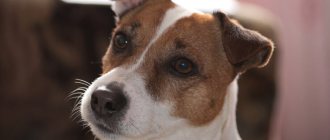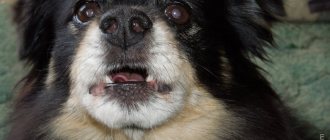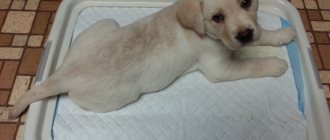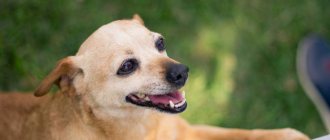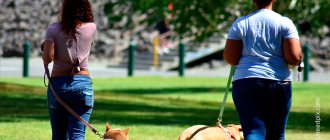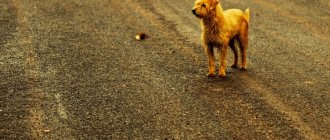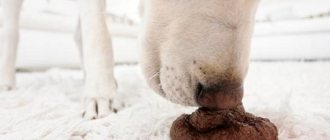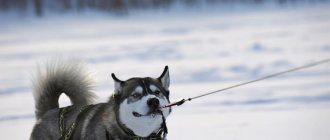Many dog owners are faced with such an unpleasant situation when, while walking, their pet throws itself at passing cars and passers-by. Not to mention the fact that such dog behavior looks ugly from the outside, it creates a danger both for the dog itself and for the people around him. That is why you should wean him off this bad habit as soon as possible.
Commands "fu" and "no"
These two commands are among the first to be studied for a reason, because it is with their help that the owner can easily control the behavior of the pet, including on the street.
As soon as you see that the dog is about to rush at moving vehicles or people passing by, then loudly and clearly command him: “You can’t!”
If the dog ignores the order, then repeat the command louder and with threatening intonations in your voice. As a rule, this is enough for the animal to change its mind about rushing at a person or car. But if the dog refuses to obey, you can reinforce the prohibiting command with a loud clap of your hands.
However, shouting does not work on some particularly stubborn dogs, and in this case, professional trainers recommend resorting to physical force. To do this, pick up a handful of very small stones, such that they cannot hit your pet too hard, and throw them from a distance of several steps at the disobedient person, while loudly pronouncing the command “No!” A threatening tone and gentle blows with small pebbles, as well as their knocking on the asphalt, will certainly make your pet become more docile and obedient.
Some dog owners replace “no” with the command “ew”. Dog handlers do not advise doing this, but if the dog has been trained to perceive the “fu” command as a general prohibition of actions, then it is necessary to use it, and not the “no” command.
In general, “fu” means a prohibition for an animal to pick up something from the ground, or with the help of this command the dog is forced to spit out what it holds in its mouth. This command differs from the “no” command, which means a prohibition of any unwanted action.
Raising a puppy
It is much easier to show the puppy that jumping on the owner for joy is not a very good habit. Correcting the habits of an adult animal requires significant effort, time and patience.
The pet begins to be raised from the first days of its arrival in the house. To wean a puppy from jumping on its owner, use the following technique:
- as soon as he tries to put his paws on a person, they give the command “sit”;
- so that the baby understands what is required of him, gently press on the croup;
- When the dog performs the required action, it is generously praised and treated with a treat.
After several repetitions, the pet is seated before it even jumps. It is important to teach your dog to obey commands without question. It is recommended to combine words with a gesture - raise your palm perpendicular to the ground. In the future, the animal will sit only on a hand signal.
“Sit” is one of the simplest commands. Even 3-month-old puppies can easily digest it.
Owners of large breed pets are advised to do things a little differently. The animal jumps on the owner to lick his face - to show love and respect. In this case, it is worth acting proactively.
When you arrive home, you should immediately kneel down and allow the dog to sniff and even lick you. If you try to rest your front paws on your chest, you must carefully place the puppy on the floor.
At this time, you need to stroke your pet and talk to him in a friendly tone. This will help raise an animal with a stable psyche - physical contact is extremely important for puppies.
As they grow older, they change their tactics. Dogs really don’t like being picked up by their front paws - they stop feeling solid support and try to break free. To wean a dog from jumping on its owner when meeting, you should use this feature to your advantage every time. Then your teenage pet will associate jumping with discomfort.
This method is not very effective with adult animals - correcting established habits requires more stringent methods.
You can also wean a grown puppy from jumping on people using the “place” command. When the dog runs up to the owner who has come home, he is petted and taken to his bed. After undressing, the person should approach the pet and sincerely praise it for waiting patiently.
Use a leash
You should not let your dog off the leash on a busy street. After all, with its help it will be possible to control the pet’s behavior even if the dog ignores prohibiting commands or has not yet been trained in them.
As soon as you notice that the dog is about to rush towards a passing vehicle or a stranger, immediately give it the command “Near!”, and after a couple of seconds, if the animal does not obey, sharply pull the leash.
Dogs of hunting breeds, as well as all terriers, must be walked exclusively on a leash, even if they are trained in all basic commands. For these dogs, chasing moving objects is an innate instinct, and no amount of training can stop them from running after people or moving vehicles.
Inadequate conditions of detention
Many dogs that are chained or outdoors for a long time react very aggressively to strangers. The reason for this may be passers-by who take advantage of the dog's limited freedom in order to tease or threaten it. Another reason may be frustration caused by severely limited freedom of movement.
Ethologists consider one of the widespread causes of aggression to be housing conditions that do not allow the dog to implement any behavior model or achieve a desired goal. Boredom is also often cited as one of the reasons. Restriction of external information and freedom of movement leads to a decrease in the threshold of irritation, which determines the intensity of the reaction to new stimuli. As a result, the dog's reaction is more intense than it would otherwise be.
Distract your pet
It is easier to prevent a situation that is conflicting or dangerous for your pet than to punish it later for an offense.
To prevent your dog from having the desire to attack a passerby or a passing car, try to keep him occupied with something more interesting while walking. For example, your favorite game or training.
If the dog tried to rush at a stranger or car, then try to get it away from there as soon as possible, and then distract it by playing or repeating commands.
General recommendations
Retraining an adult dog is a complex and lengthy process. An animal will not be able to immediately get rid of a habit that has been formed over many years. From time to time the pet will forget about the prohibitions and jump on the owner again. You need to patiently correct behavior and achieve obedience.
Those who are not ready to act persistently and consistently should turn to a dog handler for help.
To properly wean your pet, you need to consider that:
- Jumping is an expression of positive emotions. The animal does not understand that it causes inconvenience to a person. Therefore, correction of unwanted behavior should be done gently - without shouting or violence.
- It will be easier for a pet to give up a bad habit if the owner offers him an alternative. During this period, you should communicate and play more with the dog, kneel down more often and allow it to lick your face. This way the pet will maintain psychological comfort.
- It's worth taking a few toys for a walk. It's better if the dog is busy. Then he will not have the desire to jump on strangers.
- To develop obedience, you need to become the leader of the pack: establish the correct hierarchy, show that the person is the unconditional leader. If this is not done, the dog will not consider it necessary to follow the owner’s orders.
Training a dog to jump on people is an important stage of training. The owner decides which method to choose, taking into account the size, age and temperament of the animal. The sooner training begins, the easier it will be.
If your pet does the right thing, don't forget to reward him.
When the dog, having heard the prohibiting command, stops rushing at people or vehicles and comes up to you, you should under no circumstances scold him. No matter how irritated the owner may be with the inappropriate behavior of his pet, he should always remember that if the dog does the right thing, it should not be punished.
On the contrary, you should praise your pet for its obedience and reward it with play or stroking. Just first take the animal away from crowds of people or moving vehicles.
Do not reward your dog with treats in this case, otherwise he will think that you are praising him for throwing himself at strangers and cars.
If you constantly monitor your pet’s behavior, teach it commands in a timely manner, and distract it with more interesting activities during walks, then the animal itself will not want to chase vehicles or rush at passers-by. In addition, never let your dog off the leash on the street in the city and, if possible, walk away from busy roads and crowded places.
My dog barks and lunges at people. How to wean it off?
Contents hide
Even the friendliest, “harmless” dogs sometimes develop behavioral problems. Let’s imagine a situation: in real life your dog wouldn’t hurt a fly, you don’t even take it on a leash during walks. But as soon as a runner or cyclist appears, the pet seems to be replaced - he rushes after him, barks, and behaves in a completely inappropriate manner. Naturally, you are forced to listen to complaints. Is there anything that can be done?
Reasons for “bad” behavior. They lie on the surface: perhaps you missed something from the most important stage in the development of your puppy’s personality - his socialization. It’s not for nothing that experts advise showing kids the world in all its diversity. Not all people walk sedately; there are also those who play sports, ride bicycles and skateboards. We would venture to suggest that the dog sets off in pursuit not because of the revealed hunting instincts, but because of banal curiosity. Agree, the runner behaves atypically compared to other people; he moves quickly. A well-socialized dog is enriched with impressions while still at a fairly tender age, and it is difficult to unsettle it. But don’t get discouraged ahead of time: there is still something you can do even with a mature pet. We warn you: this is very difficult, but methodical, systematic and painstaking work will help you.
Stage 1. Correcting old mistakes. To do this, you will have to socialize your four-legged friend again. What is the main difficulty? The habit of rushing and barking is firmly embedded in your pet’s subcortex; he finds his behavior absolutely correct (especially when the owners have not intervened before). As in the famous movie: “You run away, I’ll catch up.” Take your dog to a place where there are a lot of people jogging, such as a stadium. But keep your dog at a safe distance. Goal: to let her understand that people walk and run, nothing bad happens.
Stage 2. Correct behavior must be rewarded. As you know, dogs enjoy receiving treats. The method of positive reinforcement itself is based on the principle: do something well, get a reward. Having noticed the first successes, when the dog does not rush after you, but stays with you, give a treat. Reward every success. Dogs are smart, they sincerely want to please their owners. And, accordingly, they quickly understand what they can get rewarded for.
Stage 3: Stop bad behavior decisively. The pet caught someone in its field of vision and began to growl - perform a quick turn and turn its face in the opposite direction. Do not take any more “forceful” actions and leave the dog without treats.
Stage 4. Practical exercises. Finally, proceed to the most important part of the training - planning walks in crowded places. This stage should be started when the dog has already “calmed down” and stopped overreacting to runners and cyclists. Do not forget to tightly control your pet, be ready to intervene at any moment. Remember to give treats for good behavior, and make quick turns at the first sound of barking.
Material used: Stop A Dog From Running & Barking at People. Author: Stephanie Dube Dwilson. Source: cuteness.com Photo: unsplash.com
When to go without changing route
Photo from mirror.co.uk
It happens that it is impossible to change the route when attacked by a pack of dogs. For example, dogs bark when you walk along a path or paved path. Most likely, they are simply marking their territory and asking you to quickly get away from it.
In this case, you should continue to move forward, but with stops and conciliatory gestures. You should not leave such paths, because you may inadvertently go towards the den with puppies.
Slowly continue moving forward, observing the flock and its behavior. If aggression increases, stop for 10-15 seconds, turn your head away, do not look directly at the dogs, then continue moving.
If you are following an untrodden path, then it is worth returning to the beginning of the route and rearranging it taking into account the “wishes” of the flock.
How to identify bitterness
Aggression in dogs is easily detected by external signs. They differ depending on the degree of anger:
- At the initial stage,
the dog humps his back a little, pinches his tail between his paws, bares his teeth, and flattens his ears. There is no need to be afraid of such behavior - it is just a threat. If you do not provoke the animal, do not turn your back to it and do not run away, it will not attack. - With a medium form
, folds will appear on the forehead, the hair will stand on end, and the dog will look into the eyes. - Severe aggression,
in addition to initial and moderate signs, is manifested by redness of the eyes, a high tail, intermittent breathing, and sometimes uncontrolled urination. It is no longer possible to “agree” with the dog; it is worth isolating it if possible and doing everything to protect yourself.
Causing pain
Any living creature instantly reacts to pain. So a person can withdraw his arm or leg, while he focuses his attention on the object of irritation.
In dogs, this principle works approximately the same. Only animals have one feature that has not changed over time. At the moment of receiving pain, the dog automatically turns its head towards the threat, opening its mouth. She is ready to bite the source of trouble. In 90% of cases, she does exactly this, but with different strength.
For example, if you pinch a calm family dog on the side, he will suddenly turn around and lightly bite your hand. A yard dog can bite until you bleed, as it will not know you.
The only plus: in most cases, the animal will not go into a full-fledged attack, rushing at a person. People are bigger than dogs. Therefore, the latter, obeying the instincts of self-preservation, will prefer to attack once and retreat sharply.
Protection of offspring
In general, a dog is afraid of a person, since he is larger and looks much more dangerous. This is the basic principle of how the psyche of many animals works. They will not attack a larger opponent, as he may have strength that is not so easy to handle. But there are exceptions to the rules. This is the period when the bitch feeds her offspring.
In this case, she becomes, as they say, “the sea is knee-deep.” This is again due to hormonal levels and innate instincts. The animal will be aggressive towards any object or phenomenon if it is in close proximity to the puppies. A dog can bite both a person and a car tire. At these moments she has virtually no control over her behavior.
Permissiveness
This factor applies not to strays, but to domestic pets. Such animals know neither fear nor proper education. Being in “greenhouse conditions”, without proper supervision, the dog begins to feel like the master of the situation.
Owners of such pets can walk their dogs without a leash. When an animal breaks into aggressive barking and lunges at a person, they do not try to rein in their pet. Most often, such people try to calm the victim of the attack. They say "he doesn't bite" or "she just wants to play" without realizing the real risks.
Dogs of fighting breeds, which feel permissiveness on the street, are especially dangerous. The situation can become much more critical if the owners of such animals let them out for a walk without a leash or muzzle.
Types of aggression and ways to correct them
There are 10 main types of behavior caused by anger. Each of them has characteristic features and requires special correction methods.
Dominant
It appears during puberty and social maturation - at 1.5 - 3 years. More typical for males. Only 10% of bitches exhibit it. A characteristic sign is that the dog becomes even more embittered when punished.
How to prevent and correct:
- establish a clear hierarchy in the family, in which the dog will take last place;
- determine the rules of behavior for the dog and strictly adhere to them;
- prohibit the pet from sleeping on the bed or eating from the table;
- ensure that the animal obeys the first time, or at most the second time.
Food
Easily identified by the following characteristics:
- when eating, the dog bares its teeth at suitable dogs, cats, people;
- bites when trying to pick up a bowl;
- at the same time growls and greedily swallows food, and may drop it;
- Sometimes attacks of food aggression occur if the dog receives a special treat.
It develops quite often due to indulgence in food habits: feeding from the table, frequent undeserved treats, encouragement of begging. Also, food aggression appears if the animal eats before or at the same time as family members.
How to wean:
- before feeding, give the command “sit”;
- place the bowl in front of the dog and command “wait”;
- pause and allow eating with the command “may”;
- interrupt the meal with the commands “fu”, “no”, “wait”, wait a little and allow eating again;
- repeat several times.
Why does a dog react inappropriately to other dogs on the street?
The behavior of our little brothers largely depends on proper socialization and systematic training. An uncontrollable dog that shows aggression for no reason, regardless of its age, breed, size, is a real problem not only for owners, but also for other animals and people.
If a dog attacks its relatives, before choosing one or another method of correcting the pet’s behavior, you need to find out the reasons. There are no dogs that cannot be trained. There are no dogs that cannot be taught to respond appropriately to other dogs. There are incorrectly chosen methods for correcting behavioral manners.
Advice! Analyze how your dog treats other animals or his fellow animals. At what moments does the dog show aggression, which provokes such behavior.
Reasons for dog aggression towards its relatives:
- errors in education;
- improper adaptation, socialization;
- lack of contact with relatives and other animals;
- psychological trauma;
- dominance, emotional overexcitation;
- insufficient physical and mental stress;
- sexual competition;
- physical discomfort, severe pain;
- breed characteristics (hunting, fighting, guard breeds).
This behavior in dogs may be caused by territorial aggression. Following the instincts inherent in nature, dogs can protect their territory from the introduction of strangers. And this can be not only a private yard, closed areas, but also ordinary walking areas or areas adjacent to them. Dogs behave aggressively towards their relatives, feeling like rulers in certain territories.
Aggression can be a manifestation of dominance. Difficulties and problems in communicating with relatives on the street are most often noted in animals with clearly expressed dominant behavior. Strong individuals suppress the weak, showing their advantage and strength. In addition, such dogs often strive to take the place of leader in the family, which they consider their pack.
Stick and stone are ambiguous weapons
Photo from installitdirect.com
If, when dogs attack you, you pretend to pick up a stick or stone from the ground and try to throw it, one or two dogs will run away from you. But not necessarily. In this case, a lot depends on the dogs' past experience.
If animals have already been thrown stones or sticks at one time and this negative experience has become fixed in their minds as painfully unpleasant, and you, being on their territory, are not yet threatening their resources, then they may temporarily retreat. But the closer you get to their values with a stick or stone, the more aggressive the animal will act.
As long as you are unarmed and not particularly dangerous to the dogs, they will be willing to tolerate you. The more other factors are added to the factor of resource protection, for example, self-defense, the more violently they will begin to behave.
If you are surrounded by three or more dogs, do not make sudden movements or step on them. Aggression comes from fear. The more frightened the flock is, the more fiercely it will defend itself.
Interruption of the hunt
Animals have a greater attention span than humans. They work within the same behavioral program, without particularly shifting their attention. Dogs are no exception. At the moment of hunting, they are passionate about only one process - searching for the victim and capturing it.
This process can be somewhat compared to the state of affect in people. When the psyche goes into deep defense and a person tries with all his might to destroy his opponent, without realizing his actions.
In dogs, this process is not aimed at harming the offender. Its task is to catch the victim. However, at the moment the dog is extremely concentrated on the jerk, and if it is distracted, then all the accumulated energy can splash out on a new source. In our case, per person.
Therefore, it is better not to touch the dog if you see that it is concentrating on the jerk or is in the process of chasing. Moreover, you should not interfere with a pack of dogs chasing their prey. If you need your dog's attention, it is best to call him first so that the pet comes out of the state of heightened attention.
Socializing a puppy is the best prevention
All owners who bring a puppy into their home want to raise an adequate, obedient adult dog. Why do desires not coincide with reality? The main reason is that the owner, who perceives the puppy as a toy, does not see him as a future threat.
In order for a dog to adequately relate to the outside world, it must receive active and timely socialization.
- Once your puppy has received his basic vaccinations, he should be taken for walks as often as possible.
- Try to let your pet communicate with other animals and people, gain experience and learn to distinguish intentions in the process of communication.
- While your pet is small, adult dogs will not harm him, but will teach him the basic rules of pack behavior.
Important! Against the background of active socialization, it is necessary to raise and train the puppy. By the age of one year, your pet should know at least basic commands that will allow you to control its actions and movement during a walk.
Never encourage your puppy's aggression, even if it manifests itself in a playful way. Kids often rush at each other with a growl and imitate a fight. There is no need to prohibit such actions, but they should not be encouraged either.
Never praise your dog for growling or barking at other animals, especially small ones. While the puppy is small, he is unable to do any real harm to another dog or cat, but as your dog grows up and knows that you encourage aggression towards small animals, he will begin to behave unpredictably.
